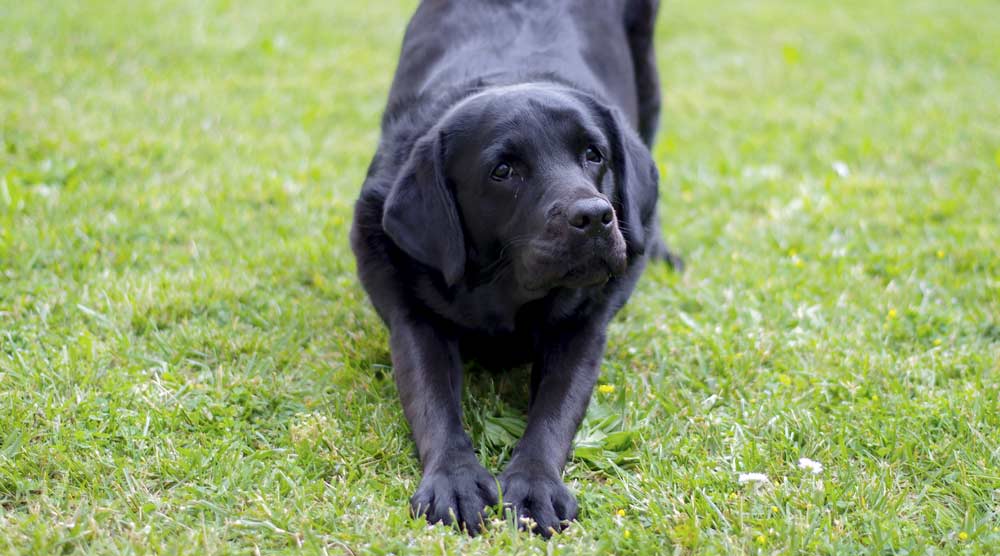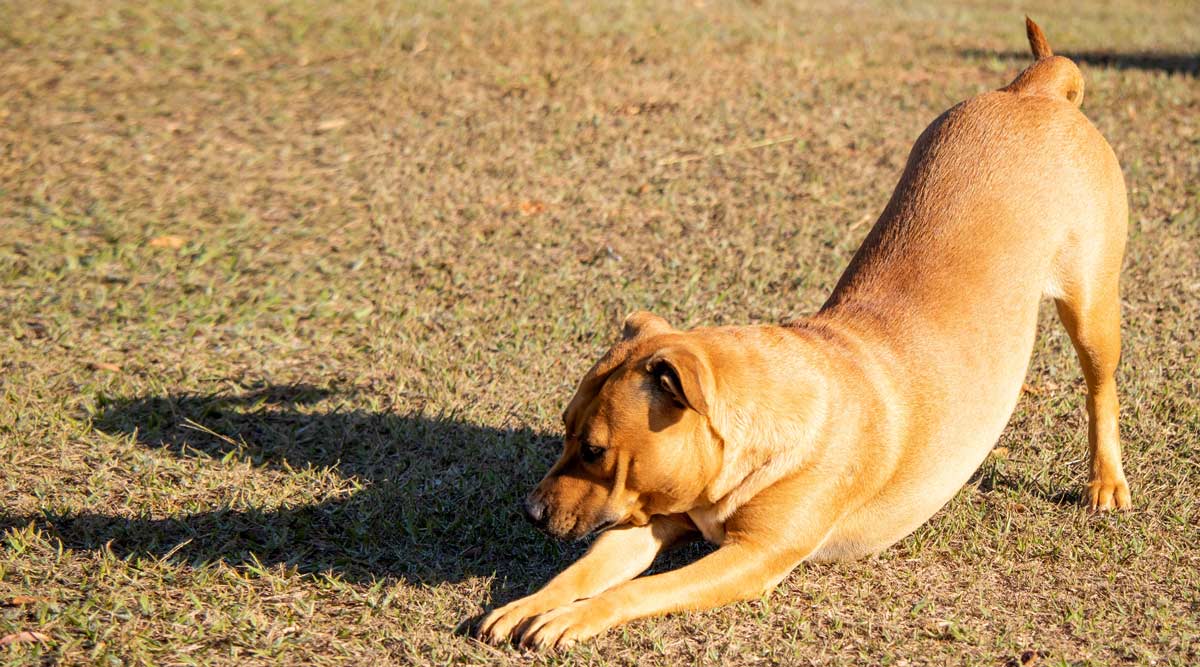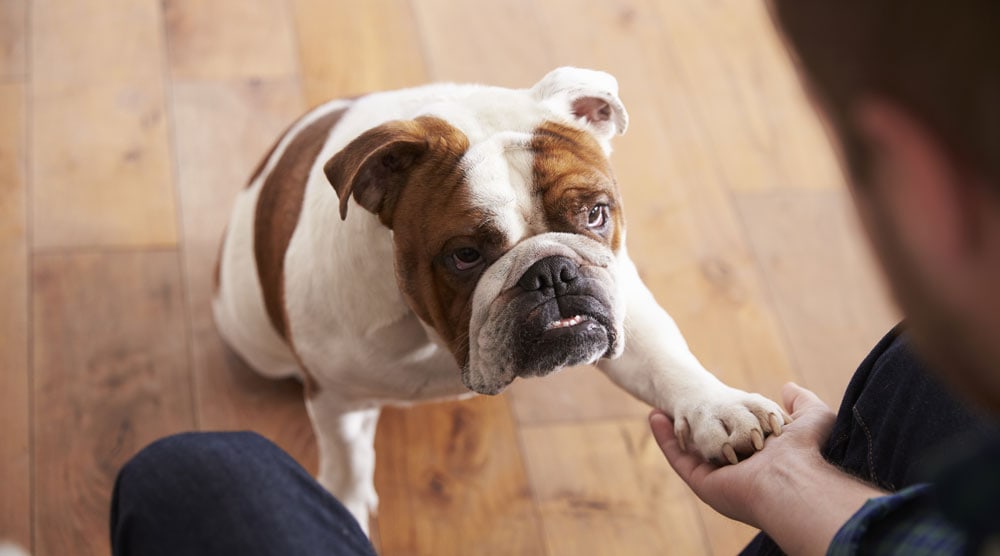The dog prayer position can be a sign that your pet is in pain, especially if your dog is stretching more than normal. When dogs stretch in this way, it relieves pressure in the abdomen, which can provide temporary relief from discomfort.
In this article, we’ll discuss the dog prayer position and when it’s a worrying sign. We’ll also talk about the potential causes of abdominal pain in dogs and when to visit a vet.
Contents
What Is The Prayer Position?

The prayer position is a natural stretch for many dogs after sleeping, but it can also be a sign of pain. It’s characterised by:
- Front legs stretched out beyond the head
- Head and chest close to the floor
- Rear end in the air
In some cases, the dog may also arch their back when in the prayer position. This is another potential sign of pain.
How is The Prayer Position Differ From A Play Bow?
The prayer position looks similar to a dog’s play bow, but with a few key differences.
When a dog performs a play bow, they are showing they are ready for a fun activity. The front legs are often wide, with the dog’s body poised to spring into action. Dogs also often show a relaxed “smile” when they are performing a play bow.
In contrast, a dog stretching in the prayer position will seem calmer and less ready for action. If the dog is in pain, their movements are also likely to be slower and more deliberate, and they won’t have the “smiling” facial expression. Additionally, the legs will probably be closer together when stretching.
Why The Prayer Position Can Indicate Abdominal Pain

Stretching in the prayer position can be a sign of abdominal pain. When a dog stretches in this way, the body position temporarily relieves pressure in the abdomen, which provides short-term relief from pain.
Excessive stretching can indicate a range of health conditions that need urgent medical care. These include bloat, pancreatitis, and even cancer.
Unfortunately, many dog owners don’t realise this stretch can be a warning sign of a serious illness. This is understandable, as healthy dogs also stretch this way, both as a greeting and to loosen their muscles after resting. Even so, it’s important to be aware that the prayer position can indicate pain.
Does The Prayer Position Always Mean Pain?

The prayer position doesn’t always mean the dog is in pain. It’s important to recognise the difference between stretching to relieve pain and regular stretching.
For example, it’s common to see dogs stretch out after resting for a while. Many dogs also stretch when they see a loved one or to relieve stress.
The key is to watch out for your dog stretching more often, holding stretches for longer durations, or stretching in unusual situations (such as stopping to stretch on a walk.) These can all be signs that something is wrong.
You should also watch for additional symptoms of stomach issues. These could include:
- Vomiting or diarrhea
- Excessive panting
- Bad breath
- Increased drooling
- Shaking or whimpering
- Bloated stomach
- Changes to appetite
- Lack of energy
- Changes to behaviour
“In general, the pain in the cranial abdomen that tends to cause this sort of stretching comes on suddenly,” says vet Dr Linda Simon. “So, an owner will likely notice a very obvious and abrupt increase in stretching, along with the other signs mentioned.”
If you notice changes to your dog’s stretching, including stretching in the prayer position more often than normal, then you should contact your vet immediately. This is particularly important if the stretching is combined with other symptoms.
What Can Cause Abdominal Pain?

Pancreatitis
A common cause of the canine prayer stretch is pancreatitis.
Pancreatitis is the medical term for inflammation of the pancreas. It can happen suddenly (acute) or develop more slowly (chronic), but it always involves digestive enzymes causing inflammation in the pancreas.
Over time, this inflammation and damage can spread to the liver and potentially the rest of the body. This is one of the reasons pancreatitis is such a serious condition that needs urgent veterinary treatment. While many dogs make a full recovery with the correct care, without treatment they may die.
It’s not known exactly why pancreatitis happens in dogs. There are probably several potential triggers, including eating a large portion of fatty foods, toxins, hormonal imbalances, and trauma to the pancreas. Some dogs may also be genetically prone to chronic pancreatitis, such as Cavalier King Charles Spaniels, Boxers, and Border Collies.
One of the most common symptoms of pancreatitis is pain in the abdomen. This can cause the dog to stretch into the prayer position in an attempt to get relief. Some dogs also hunch their back, as this can have a similar effect.
Other symptoms of pancreatitis include:
- Nausea and vomiting
- Diarrhea
- Fever
- Lethargy
- Loss of appetite
You should contact your vet immediately if you notice any of these symptoms. Pancreatitis is a very painful and dangerous condition for dogs, so quick medical care is essential.
Eating Toxic Foods
A range of everyday substances can be toxic to dogs. These include many human foods, common household flowers, cleaning products, and garden plants.
Gastrointestinal symptoms are amongst the most common signs of poisoning in dogs. These can include diarrhea, vomiting, and drooling. As toxins are likely to cause abdominal pain, poisoning can also cause the dog to stretch into the prayer position.
Other symptoms of poisoning in dogs can include:
- Pale gums (can indicate internal bleeding)
- Yellow gums (can indicate liver failure)
- Faster heart rate
- Coughing blood
- Lethargy
- Change in appetite
- Change in drinking habits
- Change to urination frequency
- Altered behaviour
- Collapse
You should take your dog to the vet immediately if you suspect they have eaten something poisonous, or are showing any of the symptoms above. The sooner you get veterinary care, the better the chance that your dog will make a full recovery. . It can greatly help if you bring the packaging or a photo of the substance that caused the poisoning.
Bloat
Bloat (gastric dilatation-volvulus) is a life-threatening condition that requires urgent veterinary care. It occurs when the dog’s stomach fills with gas and twists upon itself, which seals off both the entrance and exit.
This sealing effect disrupts blood flow through the dog’s body, causing tissue damage and potential necrosis. The trapped gas also expands the stomach, which can cause severe abdominal pain and discomfort.
As we’ve already discussed, dogs naturally use the prayer stretching position to relieve pressure in the abdomen and get relief from pain. This is often the case in dogs with bloat, as the expanding gases in the stomach can cause intense pain.
Other symptoms of bloat can include:
- A hard and swollen belly
- Excessive drooling
- Pain and whimpering
- Restlessness
- Excessive panting
- Retching but unable to vomit
Take your dog immediately to your nearest vet if you suspect your dog has bloat. This condition can kill a dog within hours if they don’t receive surgery, so don’t take any chances
Vet Note From Dr Linda Simon: “I generally see bloat in large, deep-chested breeds like the Great Dane and Doberman. Signs come on very quickly, over the course of a few hours.”
Cancer
Cancer in the abdomen can cause pain and discomfort. This can lead to the dog stretching into the prayer position to try and get relief.
An example is lymphoma in dogs, which is cancer of the lymph system. A dog suffering from this form of cancer will develop lumps in different parts of the body, including the abdomen, leading to stretching and other symptoms. These can include reduced appetite, vomiting, diarrhea, yellow gums, and increased urination.
You should contact your vet if you notice any of these symptoms, especially if you can feel swollen lumps on your dog’s body.
When Should You Visit a Vet?
You shouldn’t take any chances with your dog’s health. If you notice any symptoms of illness or changes to their behaviour, then you should contact a vet.
While the prayer position doesn’t always mean that your dog is in pain, changes to your dog’s stretching habits shouldn’t be ignored. Some warning signs include:
- Your dog is stretching more often than normal (you may want to read my guide to why dogs stretch a lot)
- Your dog is holding their stretches in the prayer position for longer than normal
- Your dog is stretching in situations where they usually wouldn’t
- Your dog is showing other symptoms of illness or discomfort
Keep in mind that the cause of abdominal pain in dogs can be serious and require emergency medical care. So, you shouldn’t delay in seeking veterinary advice if your dog is showing signs of discomfort.
Summary
The prayer position is often used by dogs who want to get relief from abdominal pain. Pain in this area can be caused by a variety of serious conditions, including bloat, cancer, and pancreatitis.
For this reason, you should always contact your vet if you notice your dog stretching in the prayer position more than normal.
Do you have any questions about the dog prayer position? Or would you like to learn more about another aspect of your dog’s behaviour? Please let us know in the comments section below. You may also want to read our article about why your dog stretches on you.




